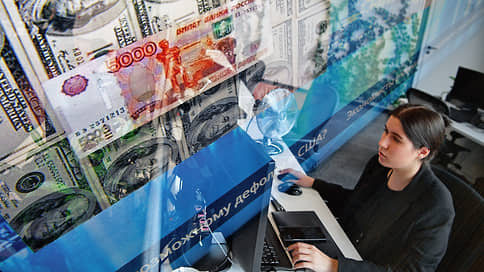the share of transactions with dollars increased, but the yuan remains the leader
[ad_1]

The volume of currency trading in August on the Moscow Exchange was the highest since February 2022. At the same time, for the first time in several months, the share of transactions with dollars increased, although the leadership was retained by the Chinese currency. At the same time, the average volume of transactions with “toxic” currencies increased. The situation is explained by the higher activity of importers and the displacement of individuals into the segment of friendly currencies.
According to Kommersant’s estimate, based on data from the Moscow Exchange, in August, the total volume of trading in major currencies against the ruble in the “today” and “tomorrow” trading modes amounted to almost 8.7 trillion rubles. This is almost a third higher than in July and the highest result since February 2022.
The strongest growth was in transactions with dollars, the volume of which increased by almost 34% over the month, to 3.37 trillion rubles. As a result, for the first time since April, the share of the American currency increased, taking almost 39% of the market against 38.2% a month earlier. Trading volume yuan grew by 32.2% to 3.92 trillion rubles, the share increased by only 0.11 percentage points (p.p.), however, the Chinese currency retained its leadership with a share of more than 45%. Share of operations with Euro decreased from 15.4% to almost 15%.
In the mode of trading with delivery “tomorrow” there was an increase in transactions in “toxic” currencies. The average size of a transaction with the dollar reached RUB 4.42 million, which is 0.24% higher than the previous month and 40% higher than the end of 2022.
The figure was higher only in March last year. A similar picture was observed in transactions with the euro, the average size of which grew by 4.5% over the month, to 4.06 million rubles, which is also a one and a half year maximum.
At the same time, for the first time since the beginning of the year, the size of transactions with the Chinese currency has decreased. According to the results of August, the average transaction with the yuan amounted to 2.44 million rubles, which is 3% lower than in July, although more than 40% higher than at the end of last year. “Due to the depreciation of the ruble, more rubles are needed to buy the same batch of imports as at the beginning of the year,” explains Mikhail Vasiliev, chief analyst at Sovcombank.
Not the last role in the consolidation of transactions with “toxic” currencies is played by a decrease in interest in such transactions on the part of private investors. “The possession of non-cash dollars and euros for individuals is becoming more difficult due to the introduction of high commissions and the inability to invest these funds anywhere within the Russian Federation,” said Vladimir Evstifeev, head of the analytical department of Zenit Bank. Last year, many banks introduced fees for maintaining foreign currency accounts. This year, some of them went further and began to introduce protective commissions for transfers of foreign currency.
The flow of activity from “toxic” currencies still goes primarily to the yuan.
According to Vladimir Evstifeev, the demand for other currencies is growing more in the corporate segment than among retail investors, as part of establishing a new concept of Russia’s foreign trade and building new import channels.
Moreover, the market indicators of the currencies of friendly countries are very different from each other. If the yuan is characterized by relatively low volatility, then the Turkish lira is very unstable. This year, it has fallen in price against the dollar by more than 40%, and in five years – more than four times. “It is unlikely that individuals can consider the lira as an instrument of capital preservation instead of the much more familiar dollars and euros,” notes independent economist Konstantin Tserazov.
In general, in the absence of an alternative to “toxic” currencies, private investors lose interest in market operations.
This is evidenced by the observations of market participants and the data of the Moscow Exchange, according to which the share of such investors in the total turnover has decreased since the beginning of the year by 10 percentage points, to 18%.
“The reduced set of instruments for investing in the conditions of closed western sites also contributes to the reduced interest of individuals in the foreign exchange market,” notes Mikhail Vasiliev. According to Mr. Tserazov, the change in sentiment may be due to the inability to receive currency in cash.
Since March 2022, the Central Bank has banned the withdrawal of foreign currency from accounts. The moratorium ends on September 9, but on September 1, the head of the Bank of Russia noted that the restrictions would be extended: “No one has canceled sanctions restrictions on the supply of cash to Russian banks, and we must keep this in mind.”
[ad_2]
Source link





